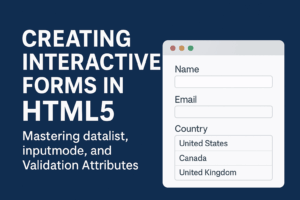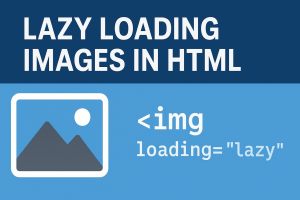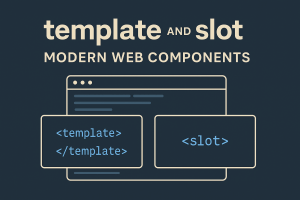Table of Contents
Mastering the HTML5 Canvas API: A Comprehensive Guide
Introduction
The HTML5 Canvas API is a powerful tool for creating dynamic graphics and interactive content directly within the web browser. Whether you’re building data visualizations, interactive games, or animations, the Canvas API provides a versatile and efficient way to bring your ideas to life. In this guide, we’ll cover the basics of the Canvas API, explore its features, and provide practical examples to help you get started.
What is the HTML5 Canvas API?
The Canvas API is a part of HTML5 that allows for the creation of 2D drawing surfaces that can be used to render graphics, animations, and other visual content. It provides a JavaScript interface for drawing shapes, images, and text on a web page.
Canvas elements are resolution-dependent and can be manipulated using a variety of methods provided by the API. This makes the Canvas API ideal for creating graphics that require pixel-level control, such as games, interactive charts, and custom graphic designs.
Setting Up the Canvas
To start using the Canvas API, you need to add a `<canvas>` element to your HTML:
<canvas id="myCanvas" width="600" height="400"></canvas>Next, you’ll need to get a reference to the canvas element in your JavaScript code and obtain a drawing context:
const canvas = document.getElementById('myCanvas');
const ctx = canvas.getContext('2d');The getContext('2d') method returns an object that provides methods and properties for drawing and manipulating graphics on the canvas.
Drawing Basic Shapes
Drawing Rectangles
Rectangles are one of the simplest shapes to draw. The fillRect() method draws a filled rectangle:
ctx.fillStyle = '#FF0000';
ctx.fillRect(50, 50, 150, 100);Drawing Circles
To draw circles, you use the arc() method:
ctx.beginPath();
ctx.arc(200, 200, 50, 0, 2 * Math.PI);
ctx.fillStyle = '#0000FF';
ctx.fill();
ctx.closePath();Drawing Lines
Lines can be drawn using the beginPath(), moveTo(), and lineTo() methods:
ctx.beginPath();
ctx.moveTo(100, 100);
ctx.lineTo(200, 200);
ctx.stroke();
ctx.closePath();Combining Shapes
Combining shapes allows you to create more complex graphics. Here’s an example of combining rectangles and circles:
ctx.fillStyle = '#FF0000';
ctx.fillRect(50, 50, 150, 100);
ctx.beginPath();
ctx.arc(200, 200, 50, 0, 2 * Math.PI);
ctx.fillStyle = '#0000FF';
ctx.fill();
ctx.closePath();Working with Images
You can also draw images onto the canvas. First, load the image and then use the drawImage() method:
const img = new Image();
img.src = 'path/to/image.jpg';
img.onload = () => {
ctx.drawImage(img, 0, 0, 300, 200);
};Adding Text
The Canvas API allows for text rendering with the fillText() method:
ctx.font = '30px Arial';
ctx.fillStyle = '#000000';
ctx.fillText('Hello, Canvas!', 100, 50);You can also use the strokeText() method to create outlined text:
ctx.font = '30px Arial';
ctx.strokeStyle = '#000000';
ctx.strokeText('Hello, Canvas!', 100, 100);Creating Animations
Animations can be achieved by updating the canvas at regular intervals using the requestAnimationFrame() function. This method provides a smoother animation compared to setInterval() or setTimeout():
function animate() {
ctx.clearRect(0, 0, canvas.width, canvas.height);
// Update your animation logic here
requestAnimationFrame(animate);
}
animate();In the animation loop, you clear the canvas and redraw your graphics, updating their properties to create the effect of motion.
Advanced Techniques
Gradients and Patterns
Gradients and patterns add visual interest to your graphics. You can create linear or radial gradients using the createLinearGradient() and createRadialGradient() methods:
const gradient = ctx.createLinearGradient(0, 0, 200, 0);
gradient.addColorStop(0, 'red');
gradient.addColorStop(1, 'blue');
ctx.fillStyle = gradient;
ctx.fillRect(10, 10, 200, 100);Patterns can be created from images using the createPattern() method:
const patternImg = new Image();
patternImg.src = 'path/to/pattern.jpg';
patternImg.onload = () => {
const pattern = ctx.createPattern(patternImg, 'repeat');
ctx.fillStyle = pattern;
ctx.fillRect(0, 0, canvas.width, canvas.height);
};Transformations
Transformations such as scaling, rotating, and translating can be applied to the canvas context using the scale(), rotate(), and translate() methods:
ctx.translate(100, 100);
ctx.rotate((Math.PI / 180) * 45);
ctx.fillStyle = '#00FF00';
ctx.fillRect(-50, -50, 100, 100);
Composite Operations
Composite operations determine how new drawings are combined with existing drawings. This is useful for creating effects like shadows, transparency, and masking. The globalCompositeOperation property sets the type of compositing operation to apply:
ctx.globalCompositeOperation = 'source-over';
ctx.fillStyle = 'blue';
ctx.fillRect(10, 10, 100, 100);
ctx.globalCompositeOperation = 'lighter';
ctx.fillStyle = 'red';
ctx.fillRect(50, 50, 100, 100);Performance Optimization
When working with the Canvas API, performance can become an issue, especially with complex animations and large drawings. Here are some tips to optimize performance:
- Use Offscreen Canvas: Draw offscreen and then copy the result to the visible canvas.
- Minimize State Changes: Reducing the number of state changes like
fillStyleandstrokeStylecan improve performance. - Clear Canvas Efficiently: Use
clearRect()to clear the canvas before each frame in an animation. - Batch Drawing Operations: Grouping drawing operations together can reduce the overhead of multiple function calls.
Conclusion
The HTML5 Canvas API is a versatile and powerful tool for creating interactive and visually engaging web applications. By mastering the basics of drawing shapes, working with images, adding text, creating animations, and exploring advanced techniques, you can unlock a wide range of possibilities for your web projects. Keep experimenting and exploring the capabilities of the Canvas API to bring your creative ideas to life.










No comment